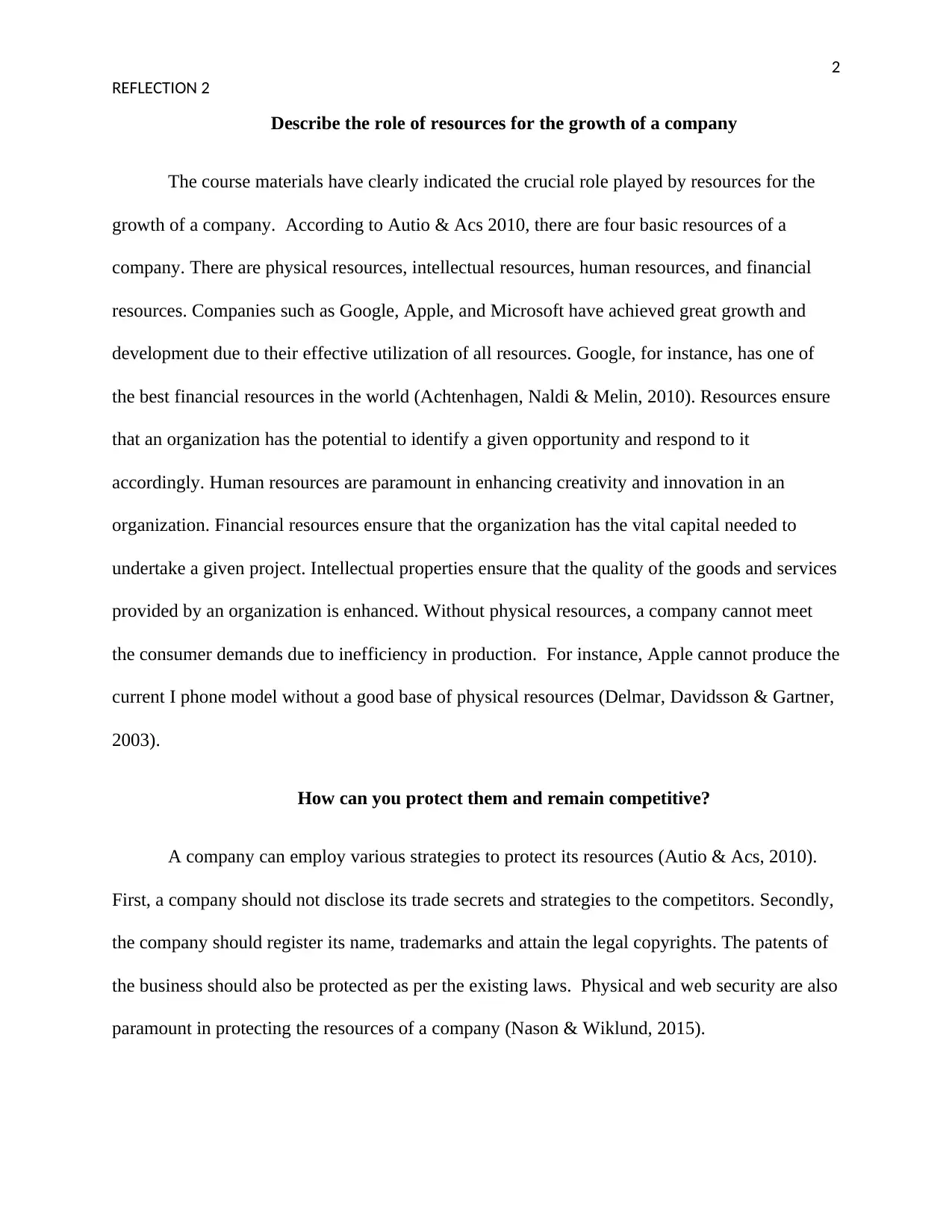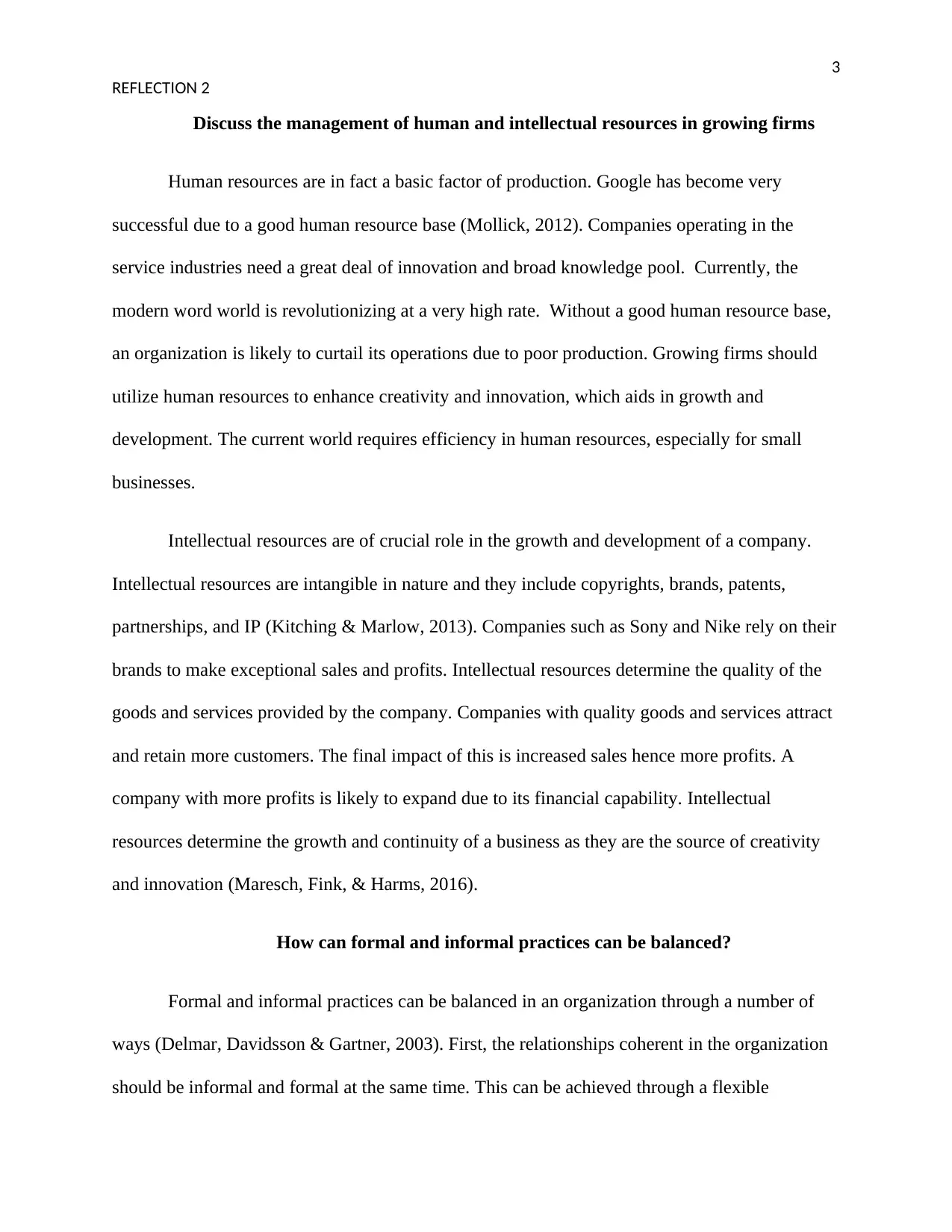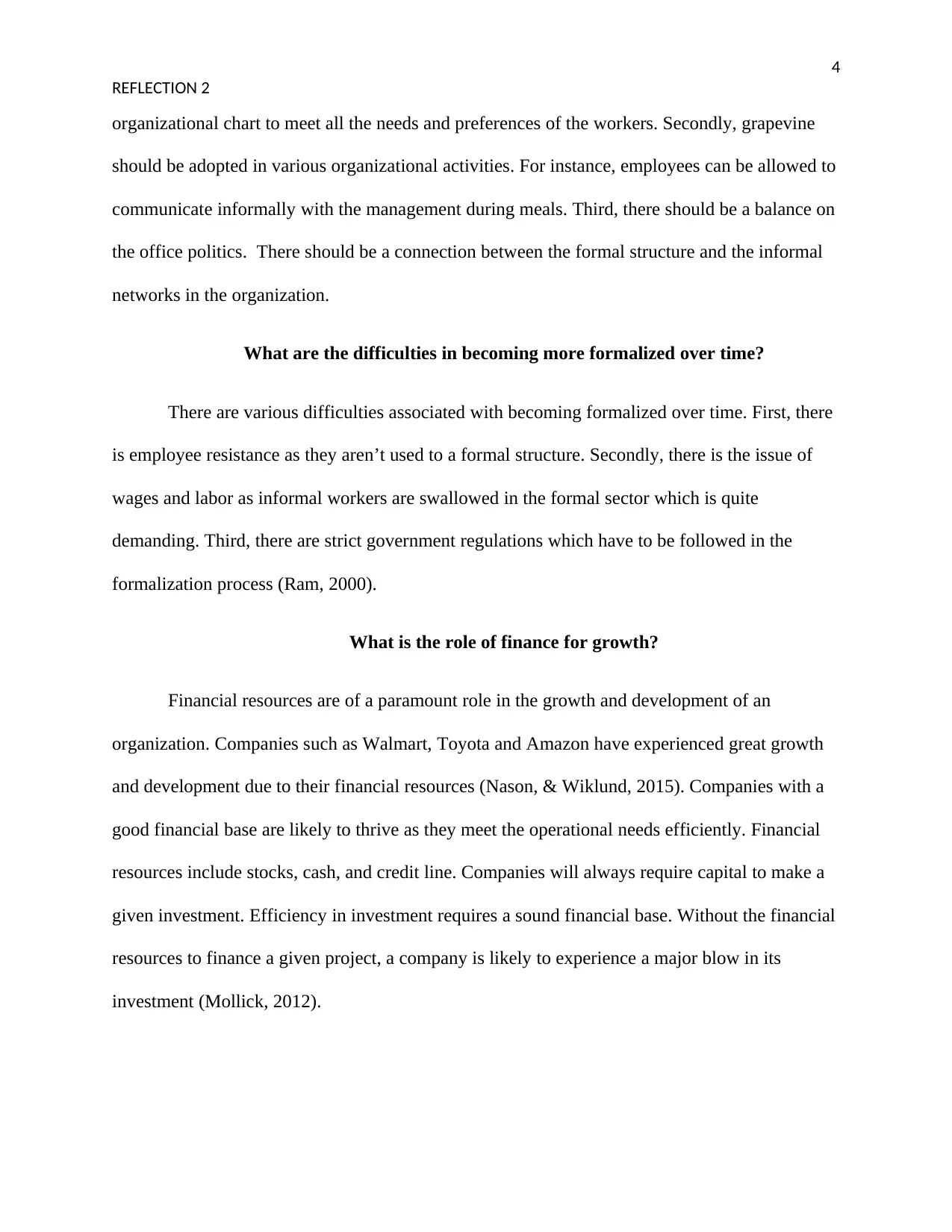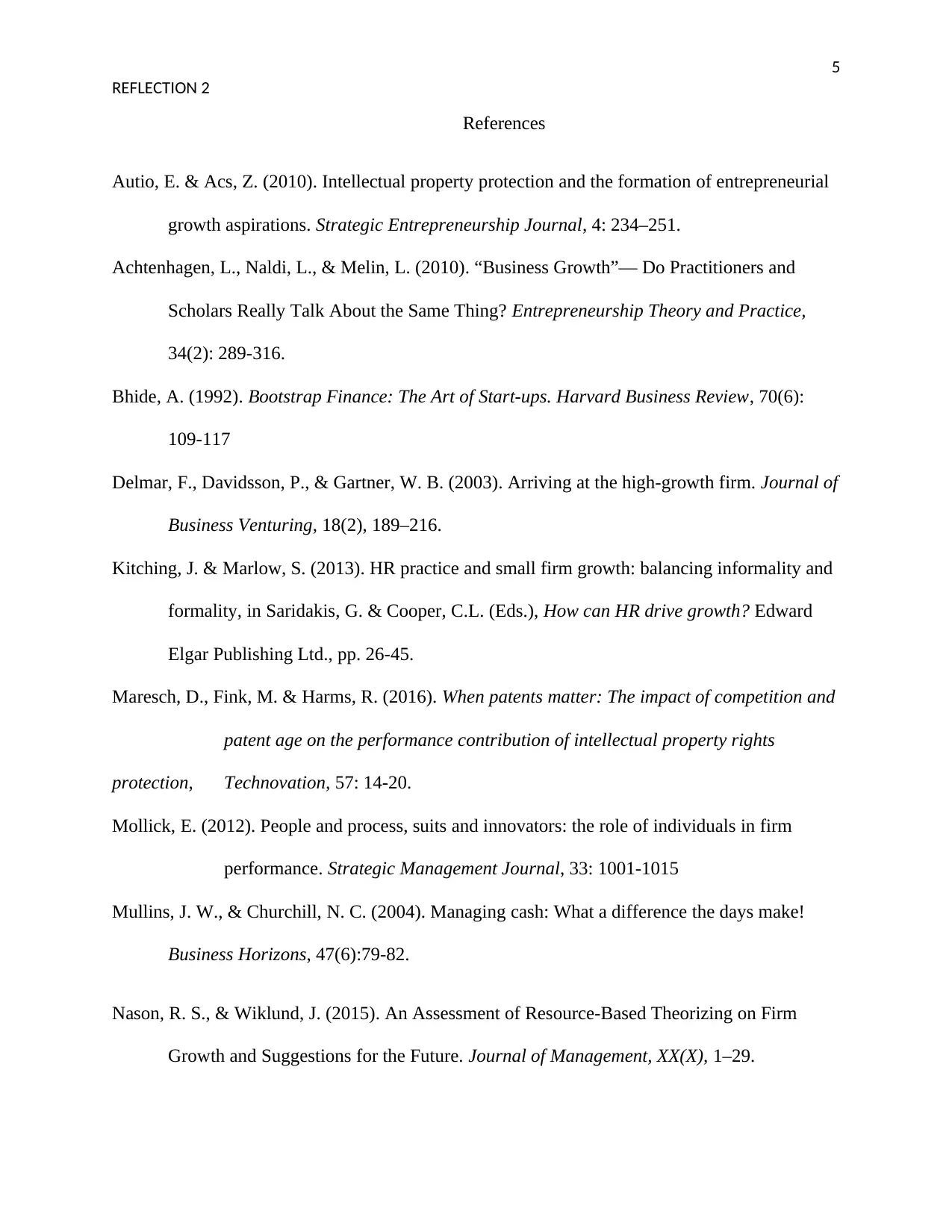Reflection 2: Entrepreneurial Growth and Resource Management
VerifiedAdded on 2023/05/27
|6
|1324
|264
Report
AI Summary
This report, titled Reflection 2, examines the multifaceted aspects of entrepreneurial growth, as explored in the course materials. It begins by highlighting the crucial role of resources – physical, intellectual, human, and financial – in fostering business expansion, using examples of companies like Google and Apple. The report then delves into strategies for protecting these resources, emphasizing the importance of safeguarding trade secrets, securing legal protections, and ensuring physical and web security. Furthermore, it discusses the management of human and intellectual resources, particularly in growing firms, emphasizing the need for creativity, innovation, and the balance between formal and informal practices. The role of finance in supporting growth is also addressed, underscoring the necessity of a sound financial base for investment and operational efficiency. The report concludes with a list of references that support the analysis.

1
Running head: REFLECTION 2
Reflection 2
Name
Institution Affiliation
Running head: REFLECTION 2
Reflection 2
Name
Institution Affiliation
Paraphrase This Document
Need a fresh take? Get an instant paraphrase of this document with our AI Paraphraser

2
REFLECTION 2
Describe the role of resources for the growth of a company
The course materials have clearly indicated the crucial role played by resources for the
growth of a company. According to Autio & Acs 2010, there are four basic resources of a
company. There are physical resources, intellectual resources, human resources, and financial
resources. Companies such as Google, Apple, and Microsoft have achieved great growth and
development due to their effective utilization of all resources. Google, for instance, has one of
the best financial resources in the world (Achtenhagen, Naldi & Melin, 2010). Resources ensure
that an organization has the potential to identify a given opportunity and respond to it
accordingly. Human resources are paramount in enhancing creativity and innovation in an
organization. Financial resources ensure that the organization has the vital capital needed to
undertake a given project. Intellectual properties ensure that the quality of the goods and services
provided by an organization is enhanced. Without physical resources, a company cannot meet
the consumer demands due to inefficiency in production. For instance, Apple cannot produce the
current I phone model without a good base of physical resources (Delmar, Davidsson & Gartner,
2003).
How can you protect them and remain competitive?
A company can employ various strategies to protect its resources (Autio & Acs, 2010).
First, a company should not disclose its trade secrets and strategies to the competitors. Secondly,
the company should register its name, trademarks and attain the legal copyrights. The patents of
the business should also be protected as per the existing laws. Physical and web security are also
paramount in protecting the resources of a company (Nason & Wiklund, 2015).
REFLECTION 2
Describe the role of resources for the growth of a company
The course materials have clearly indicated the crucial role played by resources for the
growth of a company. According to Autio & Acs 2010, there are four basic resources of a
company. There are physical resources, intellectual resources, human resources, and financial
resources. Companies such as Google, Apple, and Microsoft have achieved great growth and
development due to their effective utilization of all resources. Google, for instance, has one of
the best financial resources in the world (Achtenhagen, Naldi & Melin, 2010). Resources ensure
that an organization has the potential to identify a given opportunity and respond to it
accordingly. Human resources are paramount in enhancing creativity and innovation in an
organization. Financial resources ensure that the organization has the vital capital needed to
undertake a given project. Intellectual properties ensure that the quality of the goods and services
provided by an organization is enhanced. Without physical resources, a company cannot meet
the consumer demands due to inefficiency in production. For instance, Apple cannot produce the
current I phone model without a good base of physical resources (Delmar, Davidsson & Gartner,
2003).
How can you protect them and remain competitive?
A company can employ various strategies to protect its resources (Autio & Acs, 2010).
First, a company should not disclose its trade secrets and strategies to the competitors. Secondly,
the company should register its name, trademarks and attain the legal copyrights. The patents of
the business should also be protected as per the existing laws. Physical and web security are also
paramount in protecting the resources of a company (Nason & Wiklund, 2015).

3
REFLECTION 2
Discuss the management of human and intellectual resources in growing firms
Human resources are in fact a basic factor of production. Google has become very
successful due to a good human resource base (Mollick, 2012). Companies operating in the
service industries need a great deal of innovation and broad knowledge pool. Currently, the
modern word world is revolutionizing at a very high rate. Without a good human resource base,
an organization is likely to curtail its operations due to poor production. Growing firms should
utilize human resources to enhance creativity and innovation, which aids in growth and
development. The current world requires efficiency in human resources, especially for small
businesses.
Intellectual resources are of crucial role in the growth and development of a company.
Intellectual resources are intangible in nature and they include copyrights, brands, patents,
partnerships, and IP (Kitching & Marlow, 2013). Companies such as Sony and Nike rely on their
brands to make exceptional sales and profits. Intellectual resources determine the quality of the
goods and services provided by the company. Companies with quality goods and services attract
and retain more customers. The final impact of this is increased sales hence more profits. A
company with more profits is likely to expand due to its financial capability. Intellectual
resources determine the growth and continuity of a business as they are the source of creativity
and innovation (Maresch, Fink, & Harms, 2016).
How can formal and informal practices can be balanced?
Formal and informal practices can be balanced in an organization through a number of
ways (Delmar, Davidsson & Gartner, 2003). First, the relationships coherent in the organization
should be informal and formal at the same time. This can be achieved through a flexible
REFLECTION 2
Discuss the management of human and intellectual resources in growing firms
Human resources are in fact a basic factor of production. Google has become very
successful due to a good human resource base (Mollick, 2012). Companies operating in the
service industries need a great deal of innovation and broad knowledge pool. Currently, the
modern word world is revolutionizing at a very high rate. Without a good human resource base,
an organization is likely to curtail its operations due to poor production. Growing firms should
utilize human resources to enhance creativity and innovation, which aids in growth and
development. The current world requires efficiency in human resources, especially for small
businesses.
Intellectual resources are of crucial role in the growth and development of a company.
Intellectual resources are intangible in nature and they include copyrights, brands, patents,
partnerships, and IP (Kitching & Marlow, 2013). Companies such as Sony and Nike rely on their
brands to make exceptional sales and profits. Intellectual resources determine the quality of the
goods and services provided by the company. Companies with quality goods and services attract
and retain more customers. The final impact of this is increased sales hence more profits. A
company with more profits is likely to expand due to its financial capability. Intellectual
resources determine the growth and continuity of a business as they are the source of creativity
and innovation (Maresch, Fink, & Harms, 2016).
How can formal and informal practices can be balanced?
Formal and informal practices can be balanced in an organization through a number of
ways (Delmar, Davidsson & Gartner, 2003). First, the relationships coherent in the organization
should be informal and formal at the same time. This can be achieved through a flexible
⊘ This is a preview!⊘
Do you want full access?
Subscribe today to unlock all pages.

Trusted by 1+ million students worldwide

4
REFLECTION 2
organizational chart to meet all the needs and preferences of the workers. Secondly, grapevine
should be adopted in various organizational activities. For instance, employees can be allowed to
communicate informally with the management during meals. Third, there should be a balance on
the office politics. There should be a connection between the formal structure and the informal
networks in the organization.
What are the difficulties in becoming more formalized over time?
There are various difficulties associated with becoming formalized over time. First, there
is employee resistance as they aren’t used to a formal structure. Secondly, there is the issue of
wages and labor as informal workers are swallowed in the formal sector which is quite
demanding. Third, there are strict government regulations which have to be followed in the
formalization process (Ram, 2000).
What is the role of finance for growth?
Financial resources are of a paramount role in the growth and development of an
organization. Companies such as Walmart, Toyota and Amazon have experienced great growth
and development due to their financial resources (Nason, & Wiklund, 2015). Companies with a
good financial base are likely to thrive as they meet the operational needs efficiently. Financial
resources include stocks, cash, and credit line. Companies will always require capital to make a
given investment. Efficiency in investment requires a sound financial base. Without the financial
resources to finance a given project, a company is likely to experience a major blow in its
investment (Mollick, 2012).
REFLECTION 2
organizational chart to meet all the needs and preferences of the workers. Secondly, grapevine
should be adopted in various organizational activities. For instance, employees can be allowed to
communicate informally with the management during meals. Third, there should be a balance on
the office politics. There should be a connection between the formal structure and the informal
networks in the organization.
What are the difficulties in becoming more formalized over time?
There are various difficulties associated with becoming formalized over time. First, there
is employee resistance as they aren’t used to a formal structure. Secondly, there is the issue of
wages and labor as informal workers are swallowed in the formal sector which is quite
demanding. Third, there are strict government regulations which have to be followed in the
formalization process (Ram, 2000).
What is the role of finance for growth?
Financial resources are of a paramount role in the growth and development of an
organization. Companies such as Walmart, Toyota and Amazon have experienced great growth
and development due to their financial resources (Nason, & Wiklund, 2015). Companies with a
good financial base are likely to thrive as they meet the operational needs efficiently. Financial
resources include stocks, cash, and credit line. Companies will always require capital to make a
given investment. Efficiency in investment requires a sound financial base. Without the financial
resources to finance a given project, a company is likely to experience a major blow in its
investment (Mollick, 2012).
Paraphrase This Document
Need a fresh take? Get an instant paraphrase of this document with our AI Paraphraser

5
REFLECTION 2
References
Autio, E. & Acs, Z. (2010). Intellectual property protection and the formation of entrepreneurial
growth aspirations. Strategic Entrepreneurship Journal, 4: 234–251.
Achtenhagen, L., Naldi, L., & Melin, L. (2010). “Business Growth”— Do Practitioners and
Scholars Really Talk About the Same Thing? Entrepreneurship Theory and Practice,
34(2): 289-316.
Bhide, A. (1992). Bootstrap Finance: The Art of Start-ups. Harvard Business Review, 70(6):
109-117
Delmar, F., Davidsson, P., & Gartner, W. B. (2003). Arriving at the high-growth firm. Journal of
Business Venturing, 18(2), 189–216.
Kitching, J. & Marlow, S. (2013). HR practice and small firm growth: balancing informality and
formality, in Saridakis, G. & Cooper, C.L. (Eds.), How can HR drive growth? Edward
Elgar Publishing Ltd., pp. 26-45.
Maresch, D., Fink, M. & Harms, R. (2016). When patents matter: The impact of competition and
patent age on the performance contribution of intellectual property rights
protection, Technovation, 57: 14-20.
Mollick, E. (2012). People and process, suits and innovators: the role of individuals in firm
performance. Strategic Management Journal, 33: 1001-1015
Mullins, J. W., & Churchill, N. C. (2004). Managing cash: What a difference the days make!
Business Horizons, 47(6):79-82.
Nason, R. S., & Wiklund, J. (2015). An Assessment of Resource-Based Theorizing on Firm
Growth and Suggestions for the Future. Journal of Management, XX(X), 1–29.
REFLECTION 2
References
Autio, E. & Acs, Z. (2010). Intellectual property protection and the formation of entrepreneurial
growth aspirations. Strategic Entrepreneurship Journal, 4: 234–251.
Achtenhagen, L., Naldi, L., & Melin, L. (2010). “Business Growth”— Do Practitioners and
Scholars Really Talk About the Same Thing? Entrepreneurship Theory and Practice,
34(2): 289-316.
Bhide, A. (1992). Bootstrap Finance: The Art of Start-ups. Harvard Business Review, 70(6):
109-117
Delmar, F., Davidsson, P., & Gartner, W. B. (2003). Arriving at the high-growth firm. Journal of
Business Venturing, 18(2), 189–216.
Kitching, J. & Marlow, S. (2013). HR practice and small firm growth: balancing informality and
formality, in Saridakis, G. & Cooper, C.L. (Eds.), How can HR drive growth? Edward
Elgar Publishing Ltd., pp. 26-45.
Maresch, D., Fink, M. & Harms, R. (2016). When patents matter: The impact of competition and
patent age on the performance contribution of intellectual property rights
protection, Technovation, 57: 14-20.
Mollick, E. (2012). People and process, suits and innovators: the role of individuals in firm
performance. Strategic Management Journal, 33: 1001-1015
Mullins, J. W., & Churchill, N. C. (2004). Managing cash: What a difference the days make!
Business Horizons, 47(6):79-82.
Nason, R. S., & Wiklund, J. (2015). An Assessment of Resource-Based Theorizing on Firm
Growth and Suggestions for the Future. Journal of Management, XX(X), 1–29.

6
REFLECTION 2
Ram, M. (2000). Professionals at work – transition in a small service firm. Journal of Small
Business and Enterprise Development, 7(1): 69-77
REFLECTION 2
Ram, M. (2000). Professionals at work – transition in a small service firm. Journal of Small
Business and Enterprise Development, 7(1): 69-77
⊘ This is a preview!⊘
Do you want full access?
Subscribe today to unlock all pages.

Trusted by 1+ million students worldwide
1 out of 6
Related Documents
Your All-in-One AI-Powered Toolkit for Academic Success.
+13062052269
info@desklib.com
Available 24*7 on WhatsApp / Email
![[object Object]](/_next/static/media/star-bottom.7253800d.svg)
Unlock your academic potential
Copyright © 2020–2025 A2Z Services. All Rights Reserved. Developed and managed by ZUCOL.





